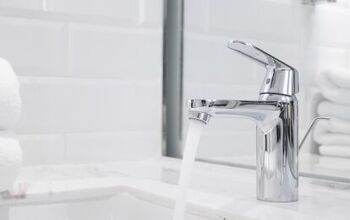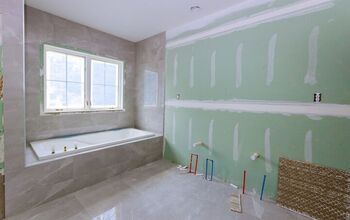Do You Need A Splashback Behind A Bathroom Sink?

Housekeepers and neat-freaks alike are constantly fighting the water stains on bathroom mirrors. Installing a splashback behind your bathroom sink can help eliminate some of this mess, but is it necessary?
While you don’t need a splashback behind your bathroom sink, it’s a good idea to have one to prevent mold. Splashbacks will also help with pesky watermarks and add a decorative flair to your bathroom aesthetic. If you haven’t installed one yet, choose from individual tiles or a solid slab and make it 15 cm high.
Continue reading to learn what a splashback is and if you need it behind your bathroom sink. We’ll also cover how to install a splashback and alternatives to using one!
Do You Need to Hire Sink Installers?
Get free, zero-commitment quotes from pro contractors near you.

What Is a Splashback?
Yes, you read that right- it’s a splashback, not a backsplash. So, what is it exactly?
A splashback is a wall or surface behind your sink, tub, or stove that has been designed to keep water or food from getting on the surrounding areas.
Some splashbacks are made of the same material as your countertop and can be installed directly behind your sink. Others look like tiles that complement the home’s aesthetic.
Either way, they help you avoid those unsightly watermarks and food stains.
Do You Need a Splashback Behind a Bathroom Sink?
The main goal of a splashback in a bathroom is to prevent droplets of water from getting on the mirror when you wash your hands or brush your teeth.
While a splashback isn’t necessary, it’s a great way to protect your bathroom from liquid splashes, soap scum buildup, and mold. Plus, a splashback can be a great way to tie together the design of your room.
It will also make it a bit easier to clean the surface behind sink faucets. If you have a mirror that runs to the bottom of the countertop, it can be difficult to reach that space.
How to Install a Splashback Behind a Bathroom Sink
If your bathroom doesn’t have a splashback, but you want to put one in, some simple prepping is required.
To install a splashback behind a bathroom sink, follow these steps:- First, you’ll need to decide whether the splashback will be a single slab or in the form of separate tiles. This decision is important because different materials require different installation methods. While some come with adhesive that allows for easy attachment, other materials might require a bit more work.
- Once you’ve made your decision, you may have to remove the mirror and faucet attachments to allow for working space.
- Next, measure the space and create a template of your design. The height of most splashbacks is around 15 cm. If you purchased a pre-made one, make sure that the cutouts are appropriate for your sink faucet.
- If you’re using tile as your splashback, you’ll need to get the proper tools and materials before installation. This includes a level to ensure that the tiles are even, adhesive, the tiles you plan on using, and some grout.
- Once everything is in place, you can begin laying down your tile(s) and securing them into place with the adhesive and/or grout.
- If you’re installing a single slab of material like glass or granite, make sure it’s correctly measured before applying adhesive. If you want to, you can use caulk around the edge of the sink to give it additional stability.
- Re-install your sink faucet hardware, and you’re done!
Wait for the material to dry before using your bathroom, as moisture could disrupt the drying process. This could take up to 24 hours.
Keep in mind that a splashback will now take up some of the space a mirror may have been utilizing. If your mirror no longer fits, you’ll have to get a new one outfitted to the space.
Alternatives to a Splashback Behind a Bathroom Sink
If you decide that installing a splashback isn’t right for your bathroom or won’t fit into your budget, then there are other options that might work better.
Alternatives to putting a splashback behind your bathroom sink are to:
- Install a temporary wall made of acrylic or something that can block some of the water from spraying on the walls.
- Turn down your water pressure, or don’t have the sink on all the way.
- Decorate the wall behind your bathroom sink with wallpaper. While this might not prevent any water from getting on the walls, it can be a fun way to spruce up your bathroom’s appearance.
- Leave the space behind your sink as-is. This is an option for those who don’t mind spending the time cleaning their mirror and walls after every use.
Whether you decide to install a splashback or not, this simple design choice can go a long way in protecting the integrity of your bathroom walls. Even if they aren’t damaged by spraying water, they may begin to show signs of aging with the moisture that is trapped behind the mirror, even after it has been cleaned up.
If you’re looking for a way to upgrade your bathroom without doing too much work, then a splashback is definitely worth considering!
Related Questions
Are splashbacks outdated?
The answer to this question depends on who you ask.While some people feel that splashbacks are outdated, others think they make the bathroom look more modern. If you’re just looking for something to prevent water from getting on the walls, then a simple temporary wall or alternative may be all that’s required.
How much do splashbacks cost?
The cost of a splashback will vary by material.On average, it costs about $500 for the installation and materials required to put a splashback behind your bathroom sink.
How do you remove a splashback?
To remove an existing splashback, you’ll need to clean it thoroughly and use a scraper to remove the old adhesive and lever the structure off.Then (if you don’t care about preserving the tiles), hammer out the pieces you can’t get off with a scraper.
Do You Need to Hire Sink Installers?
Get free, zero-commitment quotes from pro contractors near you.

The Bottom Line
A splashback is an easy way to spruce up your bathroom without having to do much work.
While you don’t need a splashback behind your bathroom sink, it serves its purpose well and can make a big difference if installed correctly.

Emily is a copywriter with over five years of experience in crafting content for the home renovation and remodeling industry. She loves house projects, whether it be painting a room or tweaking small design elements to transform a space. Her favorite aesthetic is french modern because of its clean lines and airy feeling! When not writing, Emily loves to travel and check out architectural details all over the world.
More by Emily Carr














![10 Best Cordless Leaf Blowers – [2022 Reviews & Ultimate Guide]](https://cdn-fastly.upgradedhome.com/media/2023/07/31/9070789/10-best-cordless-leaf-blowers-2022-reviews-ultimate-guide.jpg?size=350x220)












